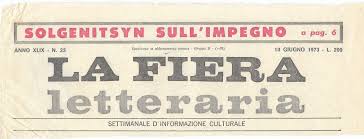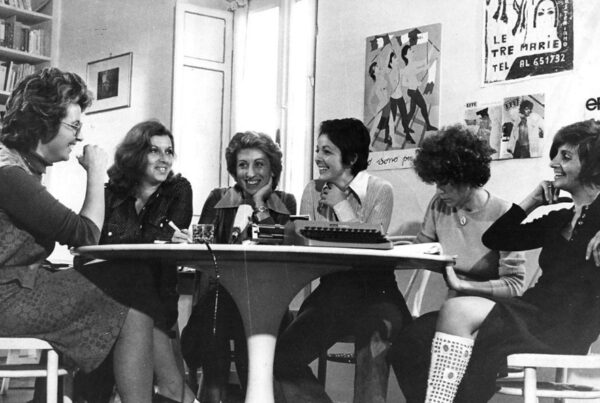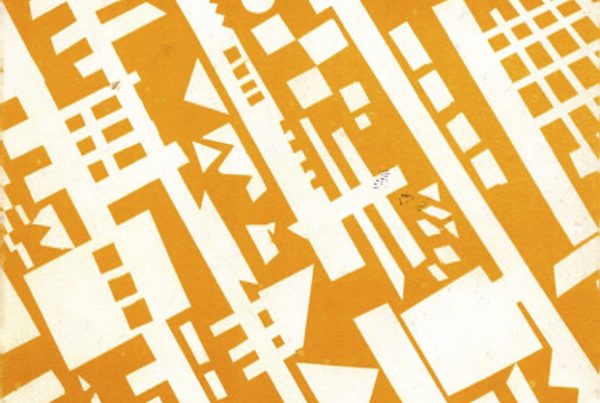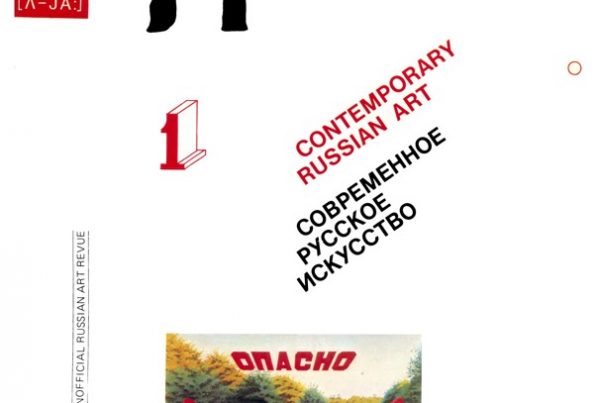
Source: picture submitted by the author.
Title:
La fiera letteraria [Literary Fair]
Dates: 1925-1977
Edition places: Milan; Rome (since 1928)
Interruptions: 1936-1943; 1969–1970
Total number of fascicles: 477 (from 1946 to 1977)
Main contributors: Giovanni Battista Angioletti, Giovanni Buttafava, Nicola Chiaromonte, Gustav Herling, Jacob Popper, Carlo ripa di Meana, Ignazio Silone, Giovanni Cristini, Ferdinando Virdia, Lia Wainstein
Description:
The history of the literary and artistic weekly magazine “La Fiera Letteraria”, founded in 1925 by Umberto Fracchia, is characterized by several interruptions and changes of management. After the Second World War it resumed publishing in 1946, under the direction of Giovanni Battista Angioletti whose focus on aesthetic and literary questions was typical of most cultural magazines of the Italian Republic which steered clear of political debate. From the 1960s the magazine expanded its remit to explore socio-literary questions and social issues, increasingly imitating, also in its layout, the illustrated magazines of the period.
Over the years it defended the independence of the literary sphere from politics, declaring itself ideologically neutral and refusing to take sides during the Cold War period. Despite this, the magazine had a Catholic-humanitarian outlook and was openly anti-Soviet and anti-communist. From the 1950s “La Fiera Letteraria” took an interest in disseminating works in opposition to the official culture of the USSR, and in general the countries of the communist bloc, publishing works on artistic-literary movements, as well as promoting freedom of the press and expression, and describing the general condition of intellectuals under Communism.
Attacks on the Soviet system gradually became more pronounced, especially after the failure of the Thaw and consequently of attempts by the West, such as those of COMES (The Community of European Writers), to build diplomatic bridges between Western European intellectuals and progressive figures beyond the Iron Curtain. The magazine, however, always regarded its critical attitude towards the USSR to be driven by moral obligation rather than political ideology.
In 1956, the editors defended the magazine’s right to side with the Hungarian people, whose oppression was described as “a human fact”. The Soviets were viewed as a “wheezing and partisan” regime attempting to justify their harsh intervention by assigning “a political or military reason to a massacre” (Redazione 1956: 10).
The magazine took a similar position with regard to the cases of Pasternak and Solzhenitsyn, which it followed from 1967.
The leading article of the first issue of January 1956, discussed the phenomenon of Soviet and Eastern dissent and condemned the regimes behind the Iron Curtain, stating that the aim of the magazine was to “update the reader and initiate debate about the state of freedom and culture in the world” (Labedz, Hayward 1966: 2).
Up to the mid 1960s, “La Fiera Letteraria” covered the seesawing political reality of the Soviet Thaw, with articles on figures such as Aleksandr Tvardovskii and Anna Akhmatova, who was able to travel to Italy to receive the Taormina prize in 1966, thanks to the efforts of COMES who opened channels of communication to promote the liberalization of Soviet culture.
As it became clear that the tendency towards greater freedom would not be long-lived, the magazine became critical of figures who had promoted collaboration with official Soviet culture and after Iosif Brodskii was arrested and sentenced in September 1964 it declared its opposition to the position of Giancarlo Vigorelli.
After the arrests of Iulii Daniel’ and Andrei Siniavskii in 1965 and the Soviet occupation of Prague in 1968, “La Fiera Letteraria” openly questioned the role of the European Community of Writers, publishing pieces by dissenting intellectuals such as Gustav Herling. The magazine chose to support the Italian Union for Cultural Progress which was founded at this time and began to focus on writers who had suffered political persecution. It gave space both to intellectuals still living in the USSR and to those in exile, providing its predominantly Italian readership with news on the variegated world of Soviet underground culture.
The magazine covered the work of Daniel’ and Siniavskii before the true identities of Arzhak and Terts were widely known and showed interest in less famous writers such as the Ukrainian nationalist writers V. Simonenko and I. Svetlichny, the Russian playwright E. Shvarts and the poet V. Tarsis. It also published in translation the poetry of several dissident poets and discussed the contents of magazines circulating in the samizdat, some of which, such as “Phoenix” managed to reach the West.
A series of articles on the experiences of the writers B. Pilniak and E. Zamiatin, N. Zabolotskii and P. Iakir were also published in this period.
The fate of Daniel’ and Siniavskii was compared to that of other writers and dissidents, such as the Yugoslav authors M. Mihailov and M. Butovich and the East German scientist, Robert Havemann. Repression in the satellite states of the USSR was considered a direct consequence of Leninism and the inevitable outcome for all societies governed according to Marxist ideology and economic principles.
In 1967 a chapter of The Master and Margarita, which was published in the same year in Italy, translated by Milli de Monticelli, appeared in the magazine. 1967 also saw the publication in Frankfurt in the magazine “Grani” of the Transcript of the trial of Daniel and Sinyavsky. The manuscript had arrived illegally in the West and, together with Solzhenitsyn’s open letter to the Union of Writers, fuelled debate about how the West should react to non-official Soviet works. From this moment until the end of its publication, “La Fiera Letteraria” covered events relating to Solzhenitsyn. Several articles were published in support of the writer, following his expulsion from the Union of Writers and, after his arrest and exile due to the publication of The Gulag Archipelago, the magazine was one of the publications that devoted the most number of pages to the author whose fate was compared to that of A. Amal’rik, I. Gabai, A. Ginzburg, P. Grigorenko, P. Litvinov, A. Marchenko, A. Sakharov, R. and Zh. Medvedev.
Over the years, as well as essays and works by dissenting authors, “La Fiera Letteraria” published dozens of articles and reports on political, ideological and social topics, such as the history of the Soviet Communist Party, the condition of intellectuals behind the iron curtain and Soviet censorship.
Alessandra Reccia
[30th June 2021]
Translation by Diletta Bacci
Bibliography
- Balke P., Il caso Brodsky, “La Fiera Letteraria”, 4th October 1966: 4.
- Bertacchini R., Dissenso e contestazione, “La Fiera Letteraria”, 4th June 1972: 11-12.
- Cristini G., Il caso Havermann, “La Fiera Letteraria”, 31st March 1966: 5.
- Fedoronczuk W., Il ‘Diario’ di Wasyl Symonenko, “La Fiera Letteraria”, 1st August 1965: 5.
- Gaspard A., Arrestato Mihajlov. In Jugoslavia un nuovo caso Djlas, “La Fiera Letteraria”, 28th March 1965: 2.
- Herling G., I clandestini. Chi è Abram Terz?, “La Fiera Letteraria”, 7th November 1965: 1.
- Manzini G., Tre immagini dell’Achmatova, “La Fiera Letteraria”, 20th December 1964: 1, 12.
- Notizia, Sul caso Bukovskij, “La Fiera Letteraria”, 23rd January 1972: 5.
- Pini M., Come l’URSS imbrigliava il dissenso, “La Fiera Letteraria”, 28th April 1974: 4-5.
- Popescu M., La Romania ha il suo Solženicyn, “La Fiera Letteraria”, 12th March 1972: 8-10.
- Popper J., La poesia dell’altra Russia, “La Fiera Letteraria”, 6th June 1965: 6, 10.
- Popper J., La sfinge, Una nuova rivista clandestina russa, “La Fiera Letteraria”, 7th April 1966: 15.
- Popper J., Lettera da Bucarest. La ribellione della ‘vecchia guardia’ nella poesia rumena, “La Fiera Letteraria”, 23rd May 1965: 4.
- Redazione, Bilancio di una indignazione, “La Fiera Letteraria”, 25th November 1956: 10.
- Redazione, Lo scrittore deve dire la verità, “La Fiera Letteraria”, 2nd December 1956: 8.
- Redazione, Protestano gli studenti a Mosca, “La Fiera Letteraria”, 15th December 1965: 1.
- Ripa di Meana C., Umanità di Valerij Tarsis, “La Fiera Letteraria”, 7th April 1966: 3-4.
- Ruggieri G., L’arresto di Piotr Yakir. Il nome nuovo della repressione, “La Fiera Letteraria”, 17th September 1972: 11.
- Stenogramma del processo a Daniėl’ e Siniavskij: Parola per parola il processo contro Daniėl’ e Siniavskij, “La Fiera Letteraria”, 13th April 1967: 5-6.
- Vigorelli G., La letteratura non è una cosmetica. Dopo le perquisizioni, la ‘Lettera aperta’ di Solzenitsyn, “La Fiera Letteraria”, 22nd June 1967: 3-4.
- Virdia F., Pasternak e il futuro, “La Fiera Letteraria”, 19th January 1958: 10.
To cite this article:
Alessandra Reccia, La Fiera Letteraria, in Voci libere in URSS. Letteratura, pensiero, arti indipendenti in Unione Sovietica e gli echi in Occidente (1953-1991), a cura di C. Pieralli, M. Sabbatini, Firenze University Press, Firenze 2021-, <vocilibereurss.fupress.net>.
eISBN 978-88-5518-463-2
© 2021 Author(s)
Content license: CC BY 4.0





